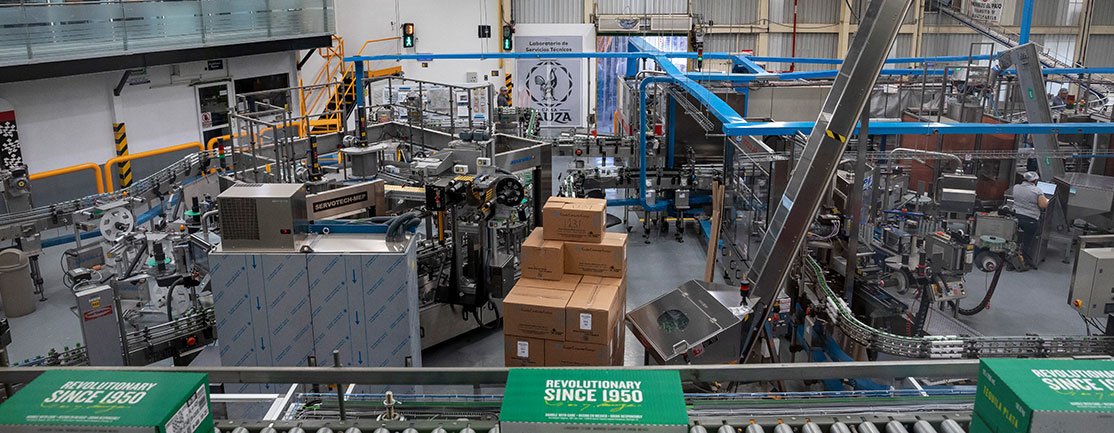
Achieving world-class performance: Casa Sauza’s journey highlights
Ed began the webinar by explaining how TRACC helps organizations achieve sustainable performance through best practice improvement. He also discussed the 5 stages of TRACC maturity and the organizational evolution that takes place at each stage.
Servando then discussed the Casa Sauza story, sharing some of the challenges the site faced before the TRACC implementation, which included: low OEE, excess inventory, service failures and limited warehouse space. Casa Sauza implemented a TPM initiative to remedy these issues, and saw some positive results, including production improvement.
To increase the gains made through TPM, Beam Suntory implemented the TRACC Solution in partnership with CCi. Two enabling best practices, Leading and Managing Change (LMC) and Operations Alignment (OA) became the cornerstones of the initiative, helping Casa Sauza overcome key challenges and make best practices a habit.
Some impressive results of the TRACC implementation include:
- 40% increase in productivity
- 74% decrease in losses
- 35% drop in labor costs
- Zero accidents for several years
Servando also shared key learnings and insights, specifically the impact the initiative has had on people empowerment, morale and performance. Managers have developed greater empathy and understanding; a strong coaching culture has emerged where teams are given the freedom and autonomy to make and execute plans; and the TRACC principles have helped improve efficiency, effectiveness and job satisfaction.
For a deeper insight into Casa Sauza’s journey to world class, watch the webinar on demand here.
Q&A session with Ed Koch and Servando Calderon
In the Q&A portion of the webinar, Servando shared valuable leadership insights and practical recommendations for other organizations on the road to continuous improvement success.
- What were your biggest challenges in incorporating TPM into the program, and how did you address the cultural change?
“The main challenge was believing that we could do it. There were times when we doubted that, but achieving quick wins really helped us move forward. When you show people that they can do it, then they become enthusiastic and start to engage. I think that’s my key learning.”
- How much time do you devote to gemba walks and to connecting with the shop floor teams?
“On Mondays, I spend almost half a day monitoring the process in the distillery, from receiving the agave to the finished products; and then I spend Tuesdays at the agave plant. Then I do weekly reports, and on Thursdays we review them for the following week.”
- How did you go about designing the autonomous training that was implemented during the pandemic?
‘’All the autonomous maintenance materials were developed by the operators. They are the best people to develop these materials, as they spend all day on the shop floor and can learn from each other.”
- How quickly do new joiners adopt the culture? And how do you manage change with regard to managers?
“We have a one-week induction period when we show new joiners the whole operation, from the agave to the supply of our product. After that, depending on the job, there’s a further three-month training period. We also have maturity stages where our people learn, and then start sharing and teaching. So, we monitor the maturity of new employees.”
- How do you integrate lean continuous improvement and digital in your program?
“Digital is becoming part of our daily lives, and I think it’s important for us to make our people aware of that. If we are ready for it, there will be more opportunities for development and growth. Our technical operators, for example, receive yellow and green belt certifications, and then we help them better understand their processes with analytics.”
‘’With all this big data, we are discovering a universe. We have more information and are detecting more patterns, and our people are enjoying the process and gaining a deeper understanding of their tasks.”
‘’Rather than just focusing on basic operational tasks, we aim to understand the underlying principles and how we will continuously improve. This applies not only to equipment modifications, which enable more efficient production, but also to the intricacies of tequila production.”
- How has TRACC contributed to the sustainability of your program, and did you have to adapt it?
“The principles need to be customized according to our needs because there’s a cultural component to consider when working with people. Different countries have different cultures. This applies to Latin America too – yes, we have similar backgrounds, but there are still cultural differences. And understanding that is critical for enhancing communication and supporting our teams more effectively.”
“Understanding our people’s cultures is also vital for successfully leading and managing change, and TRACC has supported us with this process. Every company has its own culture too. That’s why I believe that involving people and encouraging their active participation in developing the organizational culture is key.”
- Do you use management systems such as the various ISO standards together with the TRACC methodology in your program?
“Yes, we do. In the end, it’s about developing standards. So, the way we develop TRACC helps us to develop the standards and then document them with the ISO system. We usually do everything digitally. The three of them – ISO, TRACC and TPM – are connected and part of operational excellence.”
- As a high-performing site, how has the role of your leadership and supervisors changed?
“Our technical operators are now more analytical and are developing in that sense. We want self-directed teams; they are autonomous and we don’t micromanage them. One of the challenges for the managers in the empowerment model is letting people do what they need to do. Instead of being supervisors, they must become coaches. And then as a leader, I need to look toward the future and see what new technologies, systems and trends are in the market. It’s no longer about telling people what to do — they know what to do and they know how to do it better.”
